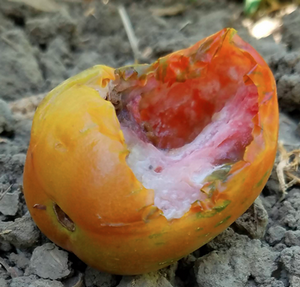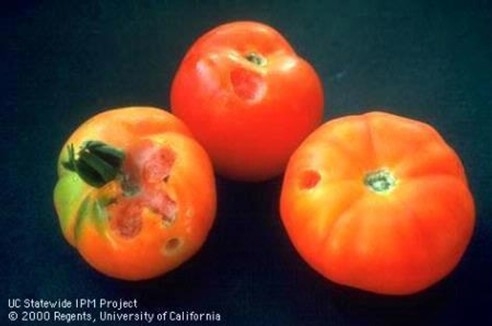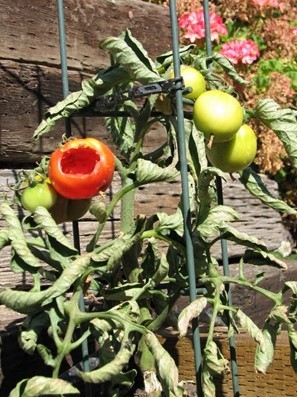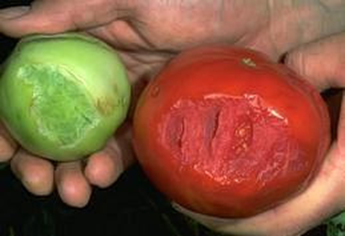It's July and the tomatoes in your garden are finally starting to ripen. One afternoon you notice the first ripe one is nearly ready to be picked. The next afternoon, you head out to harvest the tomato and find it on the ground looking like this one:

After you get over groaning about the loss of your first ripe tomato of the season, you may wonder, “What critter ate my tomato? And what can I do to stop it?” Here are some tips to answer those questions.
Many home gardeners love eating garden-fresh tomatoes. Unfortunately, many pests also love to share in the bounty of vine-ripened tomatoes. Known nibblers on home-grown tomatoes include birds, rabbits, squirrels (both ground and tree), rats, hornworms, and even slugs and snails.
Start by doing some detective work to figure out likely suspects. In this case, the half-eaten tomato was on the ground near the plant. That fact narrows the list of possible pests. It's not a hornworm, slug or snail which had no means or incentive to remove the tomato from the plant. Also, it is probably not a bird which would more likely peck on the tomato while it remains attached to the plant. So, we're left with rabbits, squirrels and rats as the leading suspects of interest.
Can you narrow the list further? Unless you live near an open space area where you've seen ground squirrels foraging near their burrows, you may also be able to eliminate that suspect as well. If you have the misfortune of trying to grow a garden close to ground squirrel territory, it would be unlikely that one missing tomato would be your first experience with the critter in your garden. Hopefully, you're already familiar with the University of California's recommendations for managing the pest. If not, you can find UC's recommendations here: https://ipm.ucanr.edu/home-and-landscape/ground-squirrel/pest-notes/?src=302-www&fr=3777 We'll assume for this blog post that we can rule out the ground squirrel.
Likewise, you may be able to rule out rabbits if they don't live anywhere near your garden. If you do live near rabbits, it would also be unlikely that your first encounter with rabbit damage to your garden would be one missing tomato. A rabbit's diet preference is for succulent, green vegetation, with grasses and herbaceous plants making up the bulk of the diet. If rabbits are in your neighborhood, UC has very good suggestions for building a fence to exclude them from your garden: https://ipm.ucanr.edu/home-and-landscape/rabbits/pest-notes/?src=302-www&fr=3783 So, we'll also eliminate rabbits from the suspects list.
Now we're left with tree squirrels and rats as our leading suspects. Both pests love to eat tomatoes—particularly just as they are ripening. Maybe you've never seen a rat in your yard or neighborhood but frequently see squirrels. Don't assume that fact means that the squirrel is the top suspect. People don't often see rats, but most of us with gardens probably have them living nearby.
A good way to know whether a rat or a squirrel caused the damage is to figure out the time of day when tomato raids occur. In this case, you visited your garden on two successive afternoons so there is no way to know for sure what time the tomato was stolen. But the culprit is almost certain to visit your garden again as more tomatoes ripen. Get in the habit of taking a walk in your garden in the evening and again early the next morning. Squirrels are active only during the daytime and rats are mainly active at night. So, if you notice a tomato that looked fine on your evening garden visit is missing or partially eaten when you visit in the morning, you know the culprit and it's time to arrest the rat. And vice versa, when the tomato raid occurs in the daytime, a squirrel is the prime suspect.
If you decide the culprit is a rat, my recommendation is that you start setting some snap traps to kill them. This UC blog post has good instructions for trapping with an easy to set snap trap: https://ucanr.edu/blogs/blogcore/postdetail.cfm?postnum=39179?src=blog43296. Be sure to take note of the blog's suggestion to bait the traps without setting them until the bait has disappeared a couple of times. Rats are very wary of new objects and will avoid them. If a rat visits an unset trap and safely eats the bait a couple of times, you're more likely to catch the rat once you start arming the trap.
If you trap a rat in your garden, you might want to do some further investigation to find where they are nesting. This UC website warns: “Once rats have invaded your garden or landscaping, unless your house is truly rodent proof, it is only a matter of time before you find evidence of them indoors.” https://ipm.ucanr.edu/home-and-landscape/rats/pest-notes/ The website also provides good directions on steps to take to make your house rat proof.
Finally, we come to the tree squirrel as the culprit—the toughest nut to crack. If you do an internet search for “how to keep squirrels from eating my tomatoes”, you'll find many sites that recommend using plant or chemical repellents with smells that squirrels don't like. The effectiveness of such repellants is questionable. Likewise, while frightening devices may work initially to keep a squirrel away, the squirrel will soon get used to it and start ignoring the device.
Live-kill squirrel traps are available, but they are much more challenging to set up and use successfully than the easily set snap traps used for rats. And some folks who are willing to kill rats may not feel the same way about killing a squirrel. Live trapping squirrels is also possible, but it is illegal to move a trapped squirrel to a new location. Squirrels trapped in a live trap must be humanely euthanized by gassing with carbon dioxide or shooting. Even if you are successful in eliminating a squirrel that was eating your tomatoes, chances are good that another squirrel will soon take over the territory and won't ignore your garden for long.
To protect a tomato plant from squirrels, consider building a cage around the entire plant using hardware cloth or chicken wire topped with plastic bird netting to exclude the squirrels from reaching the tomatoes. It may keep the squirrel out, but it will take some effort to build and will make it difficult to care for the plant and harvest ripe tomatoes.
To read UC's suggestions for managing squirrels, check out this website: https://ipm.ucanr.edu/home-and-landscape/tree-squirrels/pest-notes/?src=302-www&fr=3788
Here are a few more photos of nibbled tomatoes with links to the UC websites that tell you how to manage the culprits:
UC website: https://ipm.ucanr.edu/PMG/GARDEN/VEGES/PESTS/hornworm.html

UC Website: https://ipm.ucanr.edu/PMG/PESTNOTES/pn7427.html

Bird damage to tomato. UC website: https://ipm.ucanr.edu/home-and-landscape/birds/pest-notes/
Help Desk of the UC Master Gardeners of Contra Costa County (TKL)
